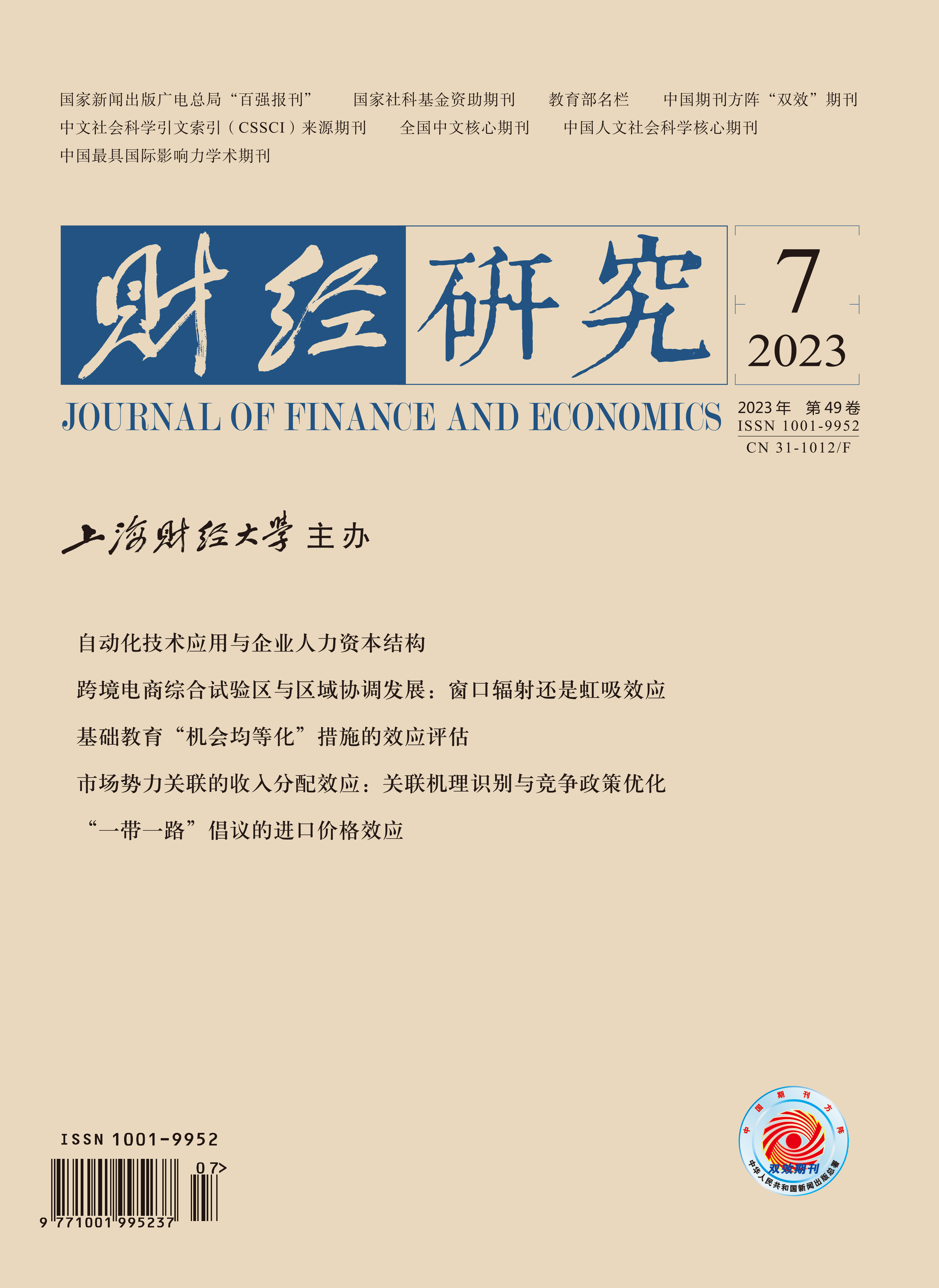进口贸易是一国引进技术与资本、繁荣国内市场的关键环节,考察“一带一路”倡议是否有助于降低沿线国家进口价格具有重要意义。文章通过拓展Antràs等(2017)的进口贸易模型,并利用双重差分方法,结合2009—2018年国家产品层面贸易数据,考察了“一带一路”倡议降低沿线国家进口价格的因果效应和作用机制。研究结果表明:(1)通过加入“一带一路”倡议,沿线国家的进口价格得到了显著的下降,这一结论在经过一系列稳健性检验后保持不变。(2)通过扩展进口来源国的竞争效应和提高进口方采购量的需求效应,“一带一路”倡议对降低沿线国家进口价格产生了积极作用。(3)“一带一路”倡议推动进口价格下降的主要动力来自集约边际,价格降幅在资本技术密集型和垄断程度较强的行业中更为明显,且对发展中国家的影响也更为显著。上述结论充分表明了“一带一路”倡议对于完善全球经济治理体系具有重要政策含义。
“一带一路”倡议的进口价格效应
摘要
参考文献
2 戴翔,宋婕. “一带一路”倡议的全球价值链优化效应−基于沿线参与国全球价值链分工地位提升的视角[J]. 中国工业经济,2021,(6):99−117. DOI:10.3969/j.issn.1006-480X.2021.06.006
6 吕越,陆毅,吴嵩博,等. “一带一路”倡议的对外投资促进效应−基于2005—2016年中国企业绿地投资的双重差分检验[J]. 经济研究,2019,(9):187−202. DOI:10.3969/j.issn.1672-5719.2019.09.155
13 巫强,刘志彪. 本土装备制造业市场空间障碍分析−基于下游行业全球价值链的视角[J]. 中国工业经济,2012,(3):43−55. DOI:10.19581/j.cnki.ciejournal.2012.03.004
20 Adam C. On the macroeconomic management of food price shocks in low-income countries[J]. Journal of African Economies,2011,20(S1): i63−i99.
21 Amiti M, Dai M, Feenstra R C, et al. How did China’s WTO entry affect U. S. prices?[J]. Journal of International Economics,2020,126: 103339. DOI:10.1016/j.jinteco.2020.103339
22 Amiti M, Itskhoki O, Konings J. International shocks, variable markups, and domestic prices[J]. The Review of Economic Studies,2019,86(6): 2356−2402. DOI:10.1093/restud/rdz005
23 Antràs P, Fort T C, Tintelnot F. The margins of global sourcing: Theory and evidence from us firms[J]. American Economic Review,2017,107(9): 2514−2564. DOI:10.1257/aer.20141685
24 Baniya S, Rocha N, Ruta M. Trade effects of the New Silk Road: A gravity analysis[J]. Journal of Development Economics,2020,146: 102467. DOI:10.1016/j.jdeveco.2020.102467
25 Bastos P. Exposure of belt and road economies to China trade shocks[J]. Journal of Development Economics,2020,145: 102474. DOI:10.1016/j.jdeveco.2020.102474
26 Broda C, Greenfield J, Weinstein D E. From groundnuts to globalization: A structural estimate of trade and growth[J]. Research in Economics,2017,71(4): 759−783. DOI:10.1016/j.rie.2017.10.001
27 Castellares R, Salas J. Contractual imperfections and the impact of crises on trade: Evidence from industry-level data[J]. Journal of International Economics,2019,116: 33−49. DOI:10.1016/j.jinteco.2018.09.004
28 De Chaisemartin C, D’Haultfoeuille X. Two-way fixed effects estimators with heterogeneous treatment effects[J]. American Economic Review,2020,110(9): 2964−2996. DOI:10.1257/aer.20181169
29 De Loecker J, Warzynski F. Markups and firm-level export status[J]. American Economic Review,2012,102(6): 2437−2471. DOI:10.1257/aer.102.6.2437
30 De Soyres F, Mulabdic A, Murray S, et al. How much will the Belt and Road Initiative reduce trade costs?[J]. International Economics,2019,159: 151−164. DOI:10.1016/j.inteco.2019.07.003
31 Drozd L A, Nosal J B. Understanding international prices: Customers as capital[J]. American Economic Review,2012,102(1): 364−395. DOI:10.1257/aer.102.1.364
32 Fitzgerald D, Haller S. Pricing-to-market: Evidence from plant-level prices[J]. The Review of Economic Studies,2014,81(2): 761−786. DOI:10.1093/restud/rdt045
33 Fontaine F, Martin J, Mejean I. Price discrimination within and across EMU markets: Evidence from French exporters[J]. Journal of International Economics,2020,124: 103300. DOI:10.1016/j.jinteco.2020.103300
34 Goodman-Bacon A. Difference-in-differences with variation in treatment timing[J]. Journal of Econometrics,2021,225(2): 254−277. DOI:10.1016/j.jeconom.2021.03.014
35 Gopinath G, Itskhoki O. Frequency of price adjustment and pass-through[J]. The Quarterly Journal of Economics,2010,125(2): 675−727. DOI:10.1162/qjec.2010.125.2.675
36 Head K, Mayer T. What separates us? Sources of resistance to globalization[J]. Canadian Journal of Economics,2013,46(4): 1196−1231. DOI:10.1111/caje.12055
37 Heise S. Firm-to-firm relationships and price rigidity theory and evidence[R]. CESifo Working Paper Series No. 6226, 2016.
38 Humphrey J, Schmitz H. How does insertion in global value chains affect upgrading in industrial clusters?[J]. Regional Studies,2002,36(9): 1017−1027. DOI:10.1080/0034340022000022198
39 Inderst R, Montez J. Buyer power and mutual dependency in a model of negotiations[J]. The Rand Journal of Economics,2019,50(1): 29−56. DOI:10.1111/1756-2171.12261
40 Ivanic M, Martin W. Implications of higher global food prices for poverty in low-income countries[J]. Agricultural Economics,2008,39(S1): 405−416.
41 Liu Q, Qiu L D. Intermediate input imports and innovations: Evidence from Chinese firms’ patent filings[J]. Journal of International Economics,2016,103: 166−183. DOI:10.1016/j.jinteco.2016.09.009
42 Mundlak Y, Larson D F. On the transmission of world agricultural prices[J]. The World Bank Economic Review,1992,6(3): 399−422. DOI:10.1093/wber/6.3.399
43 Steinwender C. Real effects of information frictions: When the states and the kingdom became united[J]. American Economic Review,2018,108(3): 657−696. DOI:10.1257/aer.20150681
44 Thomas J, Worrall T. Self-enforcing wage contracts[J]. The Review of Economic Studies,1988,55(4): 541−554. DOI:10.2307/2297404
45 Topalova P. Factor immobility and regional impacts of trade liberalization: Evidence on poverty from India[J]. American Economic Journal:Applied Economics,2010,2(4): 1−41. DOI:10.1257/app.2.4.1
引用本文
李宁静, 闫强明, 刘冲. “一带一路”倡议的进口价格效应[J]. 财经研究, 2023, 49(7): 93-107.
导出参考文献,格式为:





 4366
4366  3353
3353

